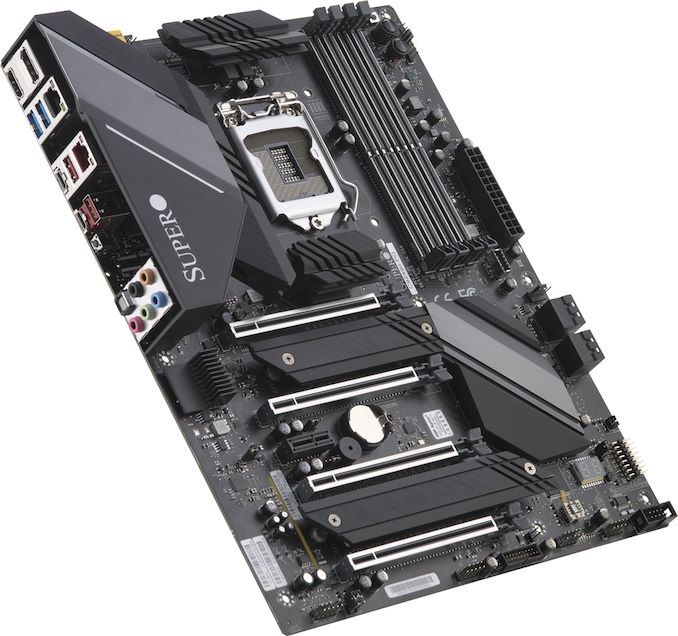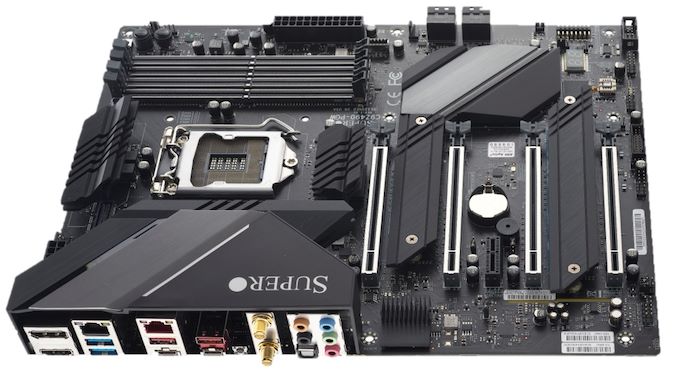The Intel Z490 Overview: 44+ Motherboards Examined
by Gavin Bonshor on April 30, 2020 10:00 AM ESTSupermicro is a name synonymous with high-grade professional workstation motherboards. Although they tend to release just a small handful of models for the desktop market, it has some models ready for Z490. We've seen quite a few Supermicro motherboards over the years, with the most recent desktop offering via the Supermicro C9Z390-PGW which included a PLX chip and 10 G Ethernet. At present, Supermicro has two ATX sized models ready in preparation for Intel's Comet Lake 10th gen desktop processors, one with Wi-Fi 6 capability and one without.
Supermicro C9Z490-PGW & C9Z490-PG
Both the Supermicro C9Z490-PGW and Supermicro C9Z490-PG share the same core feature set, with the only difference being that the C9Z490-PGW includes an Intel Wi-Fi 6 wireless interface, while the PG does not. Both include a premium controller and feature set with the most notable coming from Broadcom PEX8747 PLX chip for superior multi-graphics card support and PCIe bifurcation. Other exciting features include two PCIe 3.0 x4 M.2 slots, an Aquantia 10 G Ethernet controller, and support for up to 128 GB of DDR4-4000 memory.

The Supermicro C9Z490-PG Motherboard
Dominating the lower portion of the C9Z490-PGW and C9Z490-PG are four full-length PCIe 3.0 slots which operate at x16/x0/x16/x0 and x8/x8/x8/x8 which is made possible via a Broadcom PEX8747 PLX chip. At present this is the only Z490 motherboard that includes a PLX chip, which makes it unique for users looking to run 4-way NVIDIA SLI, or leverage the extra PCIe lanes for high-bandwidth PCIe 3.0 devices. There is also a single PCIe 3.0 x1 slot. Across its four memory slots, both models support up to DDR4-4000 with a total capacity of 128 GB. Focusing on storage, there is a pair of PCIe 3.0 x4 M.2 slots which each come with a heatsink, and four SATA ports with support for RAID 0, 1, 5, and 10 arrays. Both models are using a 6+2 power delivery with an XDPE122284C PWM controller, and TDA21490 power stages for the CPU element.

The Supermicro C9Z490-PGW Motherboard with Wi-Fi 6
On the rear panel is one USB 3.2 G2 20 Gbps Type-C, one USB 3.2 G2 10 Gbps Type-C, two USB 3.2 G2 10 Gbps Type-A, and two USB 3.2 G1 Type-A ports. Controlling the five 3.5 mm audio jacks and S/PDIF optical output is a Realtek ALC1220 HD audio codec. At the same time, one Ethernet port is powered by an Aquantia AQC107 10 G controller, while an Intel-based Gigabit controller controls the other. A small clear CMOS button is present with an HDMI 2.0a and DisplayPort 1.2 video output pairing. Last but not least on the C9Z490-PGW is an Intel Wi-Fi 6 wireless interface, likely the AX200 with BT 5.0 support.
Both the Supermicro C9Z490-PGW and C9Z490-PG are currently unique to the Z490 product stack with the inclusion of a Broadcom PEX8747 PLX controller, which allows for more PCIe bandwidth in slots which has a variety of use cases. It adds some flexibility to the Z490 chipset, something all other models at launch isn't offering. The Aquantia 10 G Ethernet controller is a common find on Supermicro's premium desktop motherboards, and its styling is very sleek and uniformed with its black and grey theme. The only pitfall is in the memory support, with the official backing for up to DDR4-4000 which is the lowest of any Z490 model we've overviewed for launch. The Supermicro C9Z490-PGW has an MSRP of $395, while the C9Z490-PG without Wi-Fi costs $375.










52 Comments
View All Comments
DanNeely - Thursday, April 30, 2020 - link
I really hate when new articles are inserted below the lead spot because it's hit or miss if I ever notice them. I missed this one during several visits to the site and only found it when Google suggested it in response to a search I made.Jedibeeftrix - Friday, May 1, 2020 - link
agreed, i found this by accident, and check AT twice or more a day.sunshinerevans55 - Sunday, May 3, 2020 - link
I basically make about $12,000-$18,000 a month online. It’s enough to comfortably replace my I was amazed how easy it was after I tried it . This is what I’ve been doing old jobs income, especially considering I only work about 10-13 hours a week from home… www.iⅭash68.ⅭomYB1064 - Monday, May 4, 2020 - link
This must have taken some writing. Kudos to the author(s). A good one stop article for anybody planning on going the Intel route. Intel seem to be adept at packaging old milk (not wine) in a new bottle. At least increase the number of PCIe lanes...boozed - Monday, May 4, 2020 - link
I recommend using the RSS feed, then you get everything and you get it chronologically.Exodite - Wednesday, May 6, 2020 - link
+1 on RSS!The "magazine layout" that plagues many sites and makes it impossible to distinguish between old articles, new articles and commercials can thankfully still be avoided through RSS.
Wardrop - Friday, May 1, 2020 - link
Funny that ASRock are the only manufacturers to have a mATX X570 motherboard for AMD's platform, yet for Intel they're the only one's NOT to have a mATX motherboard.Beaver M. - Saturday, May 2, 2020 - link
You mean they are relevant again, because they have fixed their stereotypical USB issues?Marlin1975 - Friday, May 1, 2020 - link
So in other words a re-spin of previous chipset with little to no real useful extra features but will require a new board. Classic intel. This is one of many reasons my last system was Intel and my new system is AMD now.Unless you are a intel fanboy why keep supporting this?
regsEx - Friday, May 1, 2020 - link
New networking controllers, support for PCIe 4 CPUs (RKL-S that will be released in future).Some boards also have USB Gen 2x2 support with external ASMedia controller. I know no any X570 board with USB Gen 2x2 support. Only Gen 2x1.